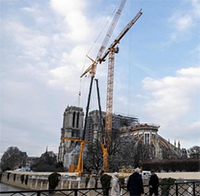|
Silent Christmas Eve at Notre Dame for First Time in Centuries
September 8, 2019
The symbolic Notre Dame Cathedral suffered extensive damage from a fire earlier this year. The blaze began on April 15, consuming the iconic 300-foot spire and burning through a large amount of wood on the inside and outside of the building. Some treasures were saved by the more than 500 firefighters who battled the blaze for 15 hours, at one point risking their lives by staying inside to build a wall of water between the fire and the bell towers. Fire officials revealed that the 850-year-old cathedral was within 15 to 30 minutes from being entirely consumed. As it was, a large amount of the wooden frames inside were charred. Much of the cathedral remained, however. The famous organ, which has 8,000 pipes, is intact. It dates to the 1730s. The cathedral's three very large rose windows are still there, as was what is thought to have been a piece of wood from the Crown of Thorns that the Bible says Jesus wore on the Cross. The cathedral was home to many more famous and irreplaceable works of art, however, and officials are already undertaking a damage assessment. Many other smaller stained glass windows already number among the artistic and architectural casualties. Donations totaling more than $1 billion have poured in from around the world and will no doubt come in handy in what is certain to be an expensive, long restoration effort. French President Emmanuelle Macron announced a timeline of five years for such a feat; experts warned that it could take decades. Macron also announced an international competition to design a replacement spire. Cleanup resumed in September, after a delay of a few months while officials ensured the safety of the workers who would be doing that cleanup. Crews fanned out in and around the cathedral and in the streets surrounding the landmark, scrubbing the pavement and rinsing the ground with chemicals, to ensure that it is safe for pedestrian traffic once again. A French environmental protection group estimated that the fire had churned through 440 tons of lead that was in the roof and the spire. Fumes and other residue from that high amount of lead could still cause health risks, the group said. Cleanup crews were wearing haz-mat suits and taking decontamination showers, but pedestrians could still get very close to the plaza, certainly within range of any contaminants still being expelled. Paris city officials had in June done testing in surrounding neighborhoods for lead contamination and had found no cause for concern; subsequent testing in August had found unacceptable levels of lead particles in the air at two nearby schools, forcing authorities to close the schools. School was not in session. Investigators still have not released an official cause of the fire. They have, however, found no evidence of arson. Cathedral officials in November began to turn on lights in the building after dark, so that the cathedral's famed exterior stone statues and figures were illuminated.
|
|
Social Studies for Kids
copyright 2002–2024
David White



 For the first time in more than two centuries, Paris's iconic Notre Dame Cathedral (left) will not have Christmas services. Instead, cathedral rector Patrick Chauvet said, the services will take place at nearby Saint-German l-Auxerrois (right), itself a church that dates to the 7th Century A.D., and will feature Notre Dame's choir singing at the midnight mass.
For the first time in more than two centuries, Paris's iconic Notre Dame Cathedral (left) will not have Christmas services. Instead, cathedral rector Patrick Chauvet said, the services will take place at nearby Saint-German l-Auxerrois (right), itself a church that dates to the 7th Century A.D., and will feature Notre Dame's choir singing at the midnight mass. The Christmas Eve mass will be an extension of the existing arrangement. Since September 1, officials of the cathedral have been conducting services at Church of Saint-German-l'Auxerrois, which was at one time the parish church for the royals who lived at nearby Louvre Palace. The existing building is the result of several iterations done through the centuries, in styles Romanesque, Gothic, and Renaissance. Prominent inside is a 15th-Century wooden statue of the namesake, Germain, who was the bishop of Auxerre.
The Christmas Eve mass will be an extension of the existing arrangement. Since September 1, officials of the cathedral have been conducting services at Church of Saint-German-l'Auxerrois, which was at one time the parish church for the royals who lived at nearby Louvre Palace. The existing building is the result of several iterations done through the centuries, in styles Romanesque, Gothic, and Renaissance. Prominent inside is a 15th-Century wooden statue of the namesake, Germain, who was the bishop of Auxerre.

